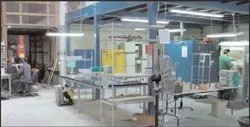Download our free Monitoring Fundamentals Tutorial.
An introduction to Monitoring Fundamentals strictly from the perspective of telecom network alarm management.
1-800-693-0351
Have a specific question? Ask our team of expert engineers and get a specific answer!
Sign up for the next DPS Factory Training!

Whether you're new to our equipment or you've used it for years, DPS factory training is the best way to get more from your monitoring.
Reserve Your Seat Today
There aren't any stops in the manufacturing process - cases are built at the same time that circuit boards are made. DPS's in-house metal shop perfectly illustrates the virtues of vertical integration. If metal work was outsourced to a stamp-and-die works, it would take up to six weeks to complete a design. If a design needed to be changed, that would take another six weeks. The DPS solution? A 50,000 PSI water jet that cuts metal to a tolerance of 0.004 inches in less than five minutes.
The metal cut by the water jet is then shaped by the press brake, which operates with 10 tons of hydraulic pressure. The press brake is computer-controlled, fast, and precise. The shaped case is coated with a powder coating that's more durable, scratch-resistant and rust-resistant. This creates a weather tolerance far higher than that provided by regular paint. The powder is fused to the metal with 15,000 volts of static electricity, then baked to seal the finish.

"The powder won't flake, it won't fall off, it won't let moisture and rust in," said Rinehart. Case graphics for control and connector labels are silk-screened onto the case. The design is created using graphics software, and from there the design goes straight to the software controlling the silkscreen machine. Changing the silkscreen to accommodate a client's custom design requires only a new design file.
After the silkscreen is applied, the case is baked a second time to make sure the finish is extra durable.